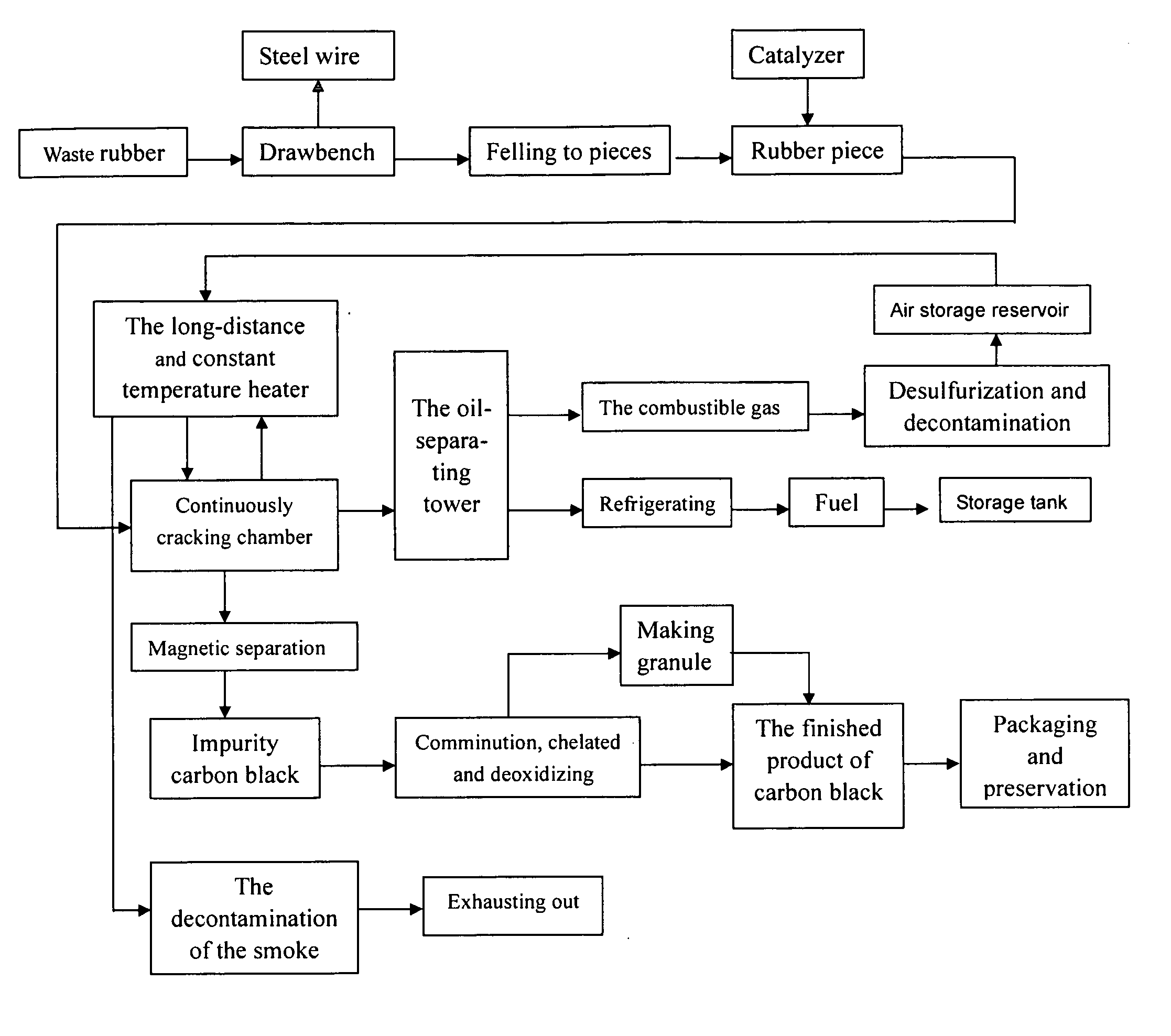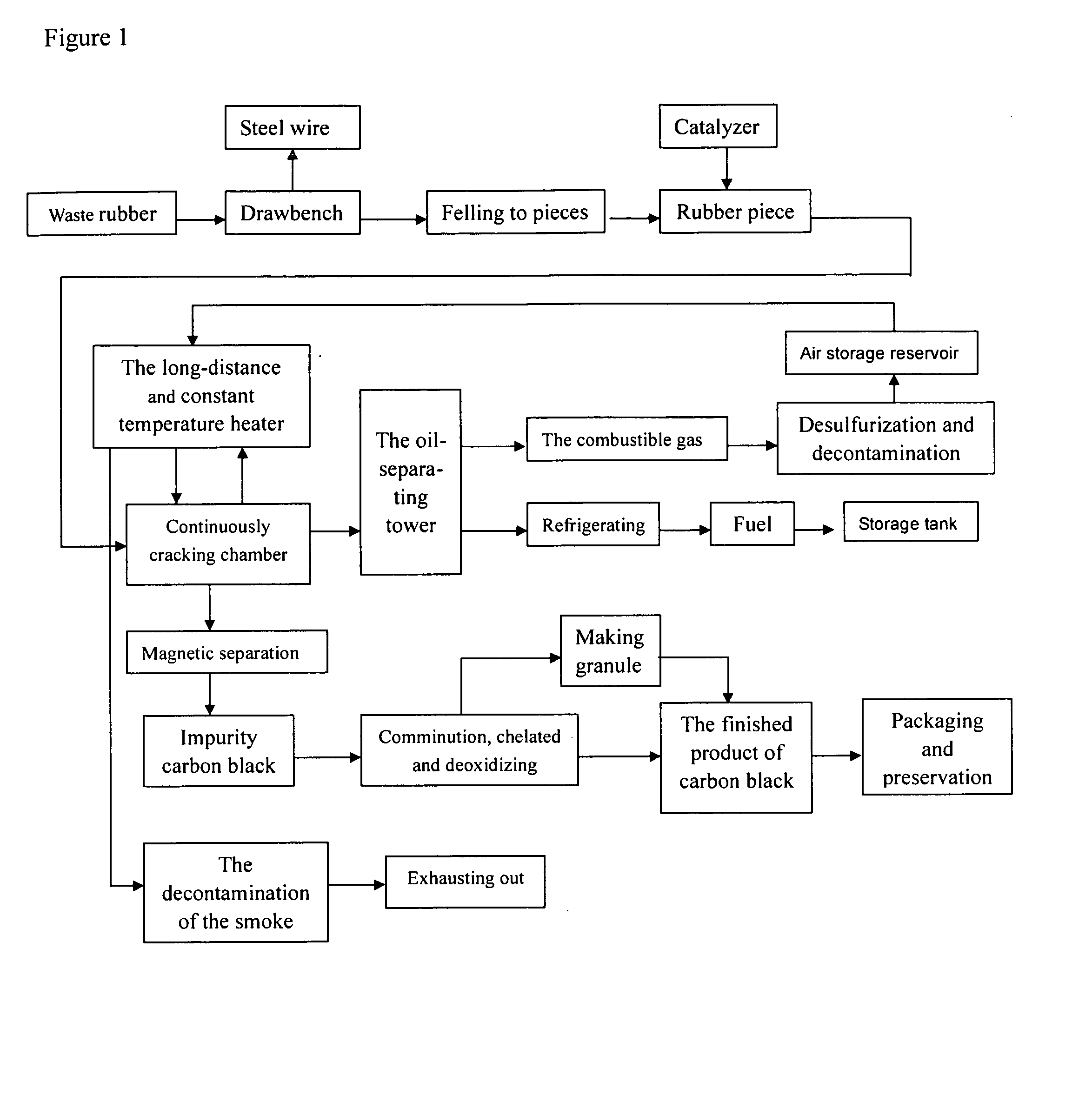Pyrolysis process for waste and old rubber
a waste and old rubber technology, applied in the cracking process of hydrocarbon oil, other chemical processes, domestic articles, etc., can solve the problems of increasing the cracking of rubber completely, and gaining the lower carbon chain of gaseous products, so as to reduce the through speed of exhaust gas, the effect of reducing the cost of equipment and reducing the cost of production
- Summary
- Abstract
- Description
- Claims
- Application Information
AI Technical Summary
Benefits of technology
Problems solved by technology
Method used
Image
Examples
example 1
[0017]The components and weight percentage of the catalyzer are as following: the model of molecular sieve is 3A, which is the aluminosilicate. The aluminosilicate is 35 wt %, the active alumina is 15 wt %, the zinc oxide is 10 wt %, the active argil is 5 wt % and the kaoline is 5 wt %. The weight ratio of catalyst and rubber is 2:1000, and then the mixture is transported into the reactor for the cracking reaction. The cracking temperature is 450° C., the cracking time is 10 minutes and the heating temperature difference in the cracking chamber is 10° C. The liquid state product can be made into needing oil by fractionating. Moreover, the gas state and solid state products can be given up directly or treated further by the conventional method. The rest parts exercise the same as the existing technologies.
example 2
[0018]The components and weight percentage of the catalyzer are as following: the model of molecular sieve is 4A, and the weight percentage is 40. The active alumina is 18 wt %, the zinc oxide is 12 wt %, the active argil is 7 wt % and the kaoline is 11 wt %. The weight ratio of catalyst and rubber is 3:1000, and then the mixture is transported into the reactor for the cracking reaction. The cracking temperature is 360° C., the cracking time is 80 minutes and the heating temperature difference in the cracking chamber is 9° C. The liquid state product can be made into needing oil by fractionating. Moreover, the gas state and solid state products can be given up directly or treated further by the conventional method. The rest parts exercise the same as the existing technologies.
example 3
[0019]The components and weight percentage of the catalyzer are as following: the model of molecular sieve is Y, and the weight percentage is 45. The active alumina is 20 wt %, the zinc oxide is 15 wt %, the active argil is 10 wt % and the kaoline is 8 wt %. The weight ratio of catalyst and rubber is 5:1000, and then the mixture is transported into the reactor for the cracking reaction. The cracking temperature is 350° C., the cracking time is 50 minutes and the heating temperature difference in the cracking chamber is 9° C. The liquid state product can be made into needing oil by fractionating. Moreover, the gas state and solid state products can be given up directly or treated further by the conventional method. The rest parts exercise the same as the existing technologies.
PUM
| Property | Measurement | Unit |
|---|---|---|
| Temperature | aaaaa | aaaaa |
| Temperature | aaaaa | aaaaa |
| Temperature | aaaaa | aaaaa |
Abstract
Description
Claims
Application Information
 Login to View More
Login to View More - R&D
- Intellectual Property
- Life Sciences
- Materials
- Tech Scout
- Unparalleled Data Quality
- Higher Quality Content
- 60% Fewer Hallucinations
Browse by: Latest US Patents, China's latest patents, Technical Efficacy Thesaurus, Application Domain, Technology Topic, Popular Technical Reports.
© 2025 PatSnap. All rights reserved.Legal|Privacy policy|Modern Slavery Act Transparency Statement|Sitemap|About US| Contact US: help@patsnap.com


